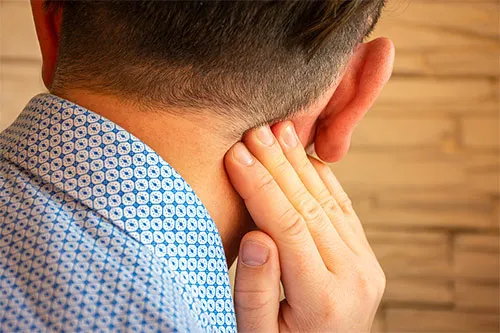
What Does a Lump Behind My Ear Mean?

What Does a Lump Behind My Ear Mean?
10 min.
Publication Date: 18 August 2023
Finding a lump behind your ear can be a concerning discovery. While it may trigger various fears and uncertainties, it's important to understand that not all lumps behind the ear are indicative of a serious condition.
Most ear lumps are harmless.
In this article, we will explore the different possible causes of a lump behind the ear and discuss their implications. We will also address the location of the lump and whether swollen lymph nodes behind the ear are dangerous. Lastly, we will delve into the treatment options available for a lump behind the ear.
What Does a Lump Behind Your Ear Mean?
A swollen lump behind the ear can stem from various causes, ranging from benign to more serious conditions. Here are some common possibilities:
Where Can the Lump be Located?
Lumps behind the ear can be found anywhere between the earlobe and the temporal bone, where glasses sit. The location of the lump can provide valuable clues about its possible cause. For example, sebaceous cysts commonly occur behind the earlobe.
Are Swollen Lymph Nodes Behind the Ear Dangerous?
While swollen lymph nodes can be a sign of an underlying issue, not all cases are dangerous. Infections, such as a common cold, can cause temporary swelling that resolves on its own.
However, if the swelling persists, worsens, or is accompanied by other concerning symptoms, medical attention should be sought to determine the underlying cause.3
How Do You Treat a Lump Behind the Ear?
Treatment for a lump behind the ear depends on its cause. Here are some common approaches:3
Summary
Discovering a lump behind your ear can evoke anxiety and worry. While some lumps are harmless and resolve on their own, others may require medical attention and intervention.
It is crucial to consult with a healthcare provider for an accurate diagnosis and appropriate treatment plan. Remember, early detection and timely treatment provides an opportunity for the best outcome.
References:
- Sebaceous Glands. Retrieved from https://my.clevelandclinic.org/health/body/24538-sebaceous-glands, on 11 May 2023.
- Lipoma. Retrieved from https://www.cancerresearchuk.org/about-cancer/other-conditions/lipoma, on 11 May 2023.
- Freedberg, et al. (2003). Fitzpatrick's Dermatology in General Medicine. (6th ed.). McGraw-Hill. ISBN 0-07-138076-0.
The information contained in this article is for educational and informational purposes only. You should not use the information as a substitute for, nor should it replace, professional medical advice. If you have any questions about your health, you should always consult with a physician or other health-care professional.
.png?branch=web_prod)
.png?branch=web_prod)

.png?branch=web_prod)